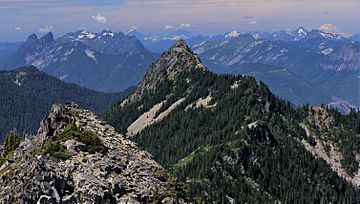Silver Eagle Peak facts for kids
Quick facts for kids Silver Eagle Peak |
|
|---|---|

South aspect centered, from Otter Point
|
|
| Highest point | |
| Elevation | 6,241 ft (1,902 m) |
| Prominence | 921 ft (281 m) |
| Isolation | 1.10 mi (1.77 km) |
| Parent peak | Bald Eagle Peak (6,259 ft) |
| Geography | |
| Location | Alpine Lakes Wilderness King County, Washington state, U.S. |
| Parent range | Cascade Range |
| Topo map | USGS Big Snow Mountain |
| Climbing | |
| First ascent | 1934 Hermann Ulrichs |
| Easiest route | class 3 scrambling Southeast Ridge |
Silver Eagle Peak is a tall mountain in Washington state, standing at 6,241-foot (1,902-metre) high. It is located about 7.7 mi (12.4 km) southeast of Skykomish. This peak is part of the Cascade Range and sits within the beautiful Alpine Lakes Wilderness. The land around it is managed by the Mount Baker-Snoqualmie National Forest.
Water from Silver Eagle Peak flows into the Foss River. The mountain is positioned right between the east and west branches of this river. A nearby mountain, Malachite Peak, is 2.6 mi (4.2 km) to the west-northwest. The closest and taller neighbor is Bald Eagle Peak, which is 1.1 mi (1.8 km) to the northeast. You can find Bald Eagle Lake between these two peaks. The first time someone climbed Silver Eagle Peak was in 1934. This was done by Hermann Ulrichs and three friends. The mountain's name, Silver Eagle Peak, became official on September 8, 1988. Some older maps might incorrectly call it Bald Eagle Peak.
What is the Weather Like on Silver Eagle Peak?
Silver Eagle Peak is in a marine west coast climate zone. This means it gets a lot of moisture from the Pacific Ocean. Most weather systems move from the Pacific Ocean towards the Cascade Mountains. When these weather systems hit the tall peaks, they are forced to rise. This causes them to drop their moisture as rain or snow onto the mountains. This process is called Orographic lift.
Because of this, the western side of the Cascades gets a lot of rain and snow. The snow here is often wet and heavy, which can increase the risk of avalanches. Winters are usually cloudy. However, during the summer, high-pressure systems over the Pacific Ocean often bring clear skies. The best time to visit or climb Silver Eagle Peak is usually from July through September.
How Did Silver Eagle Peak Form?
The Alpine Lakes Wilderness area has very rugged land. It features sharp peaks, long ridges, deep valleys carved by glaciers, and granite rock walls. There are also more than 700 mountain lakes in this area. The amazing landscape and big changes in height were created by geological events over millions of years. These events also led to the different climates you see across the Cascade Range.
The Cascade Mountains started to form millions of years ago. This was during a time called the late Eocene Epoch. The North American Plate was slowly moving over the Pacific Plate. This movement caused many periods of volcanic activity. Also, small pieces of the Earth's crust, called terranes, helped create the North Cascades about 50 million years ago.
Over two million years ago, during the Pleistocene period, glaciers repeatedly moved across the land. These glaciers carved and shaped the landscape. The last glaciers in the Alpine Lakes area began to melt and retreat about 14,000 years ago. By 10,000 years ago, they had moved north of the Canada–US border. The "U"-shaped valleys you see today were formed by these glaciers. The lifting of the land (uplift) and faulting, along with the glaciers, have been the main forces that created the tall peaks and deep valleys of the Alpine Lakes Wilderness.



